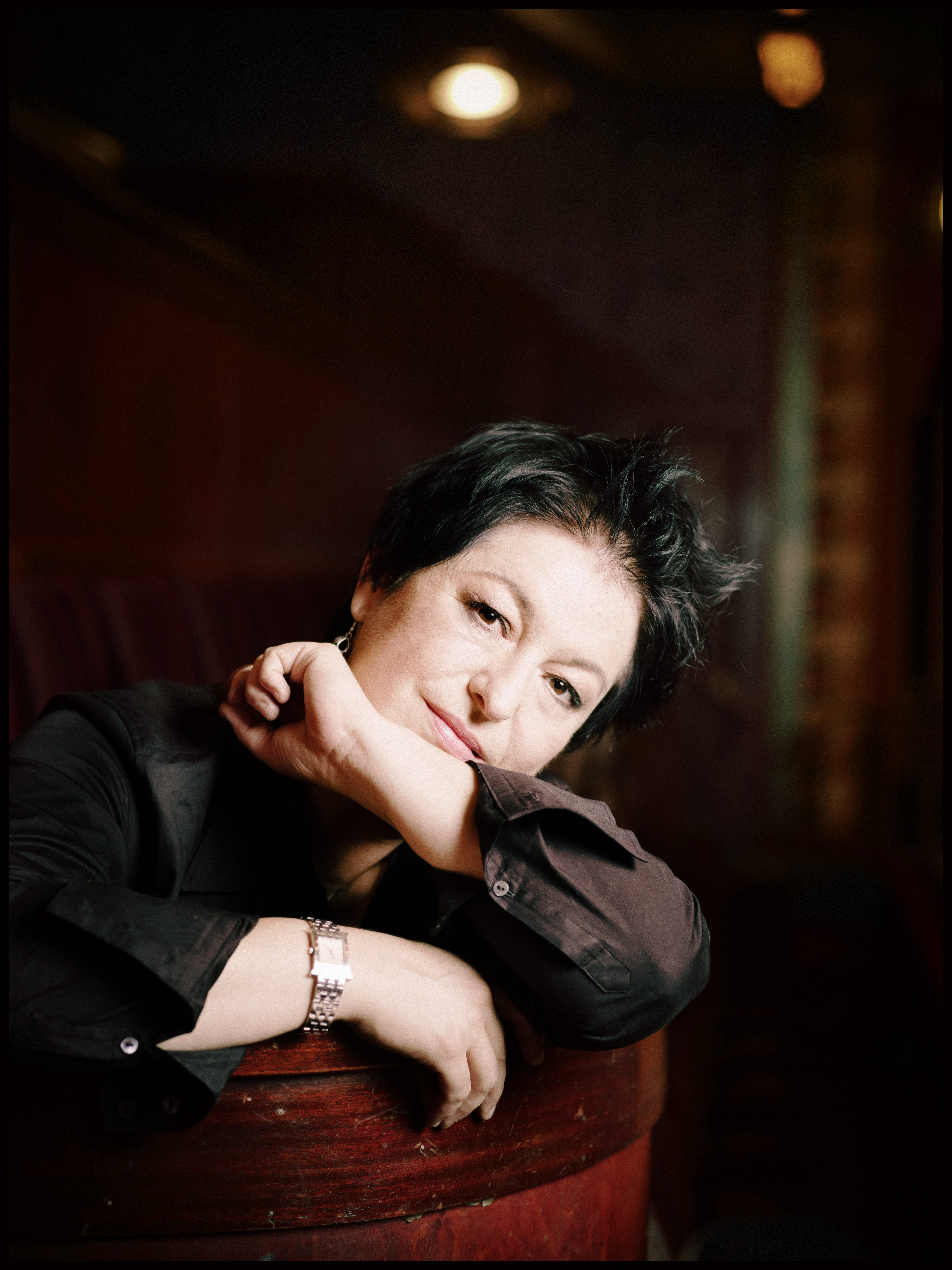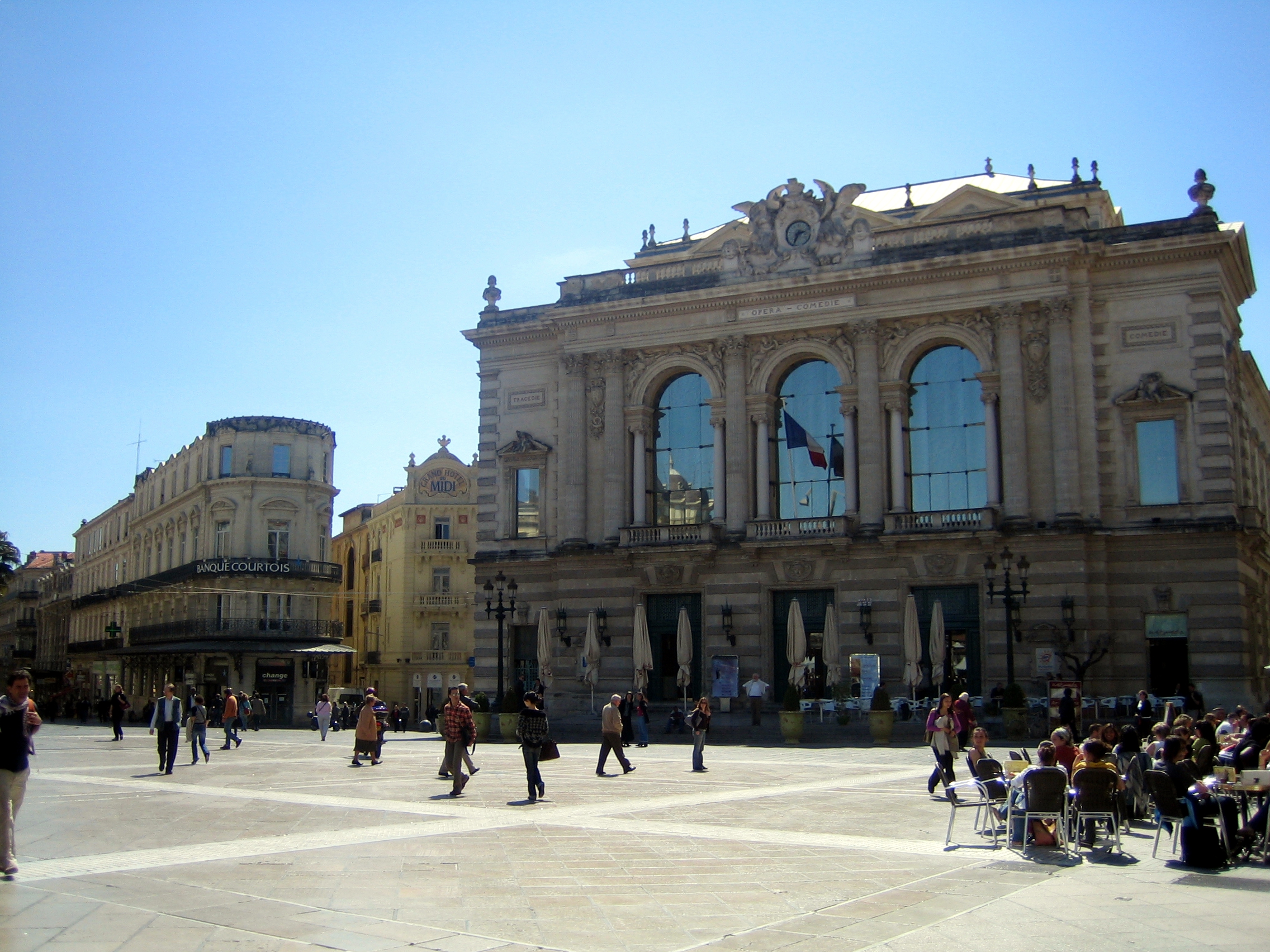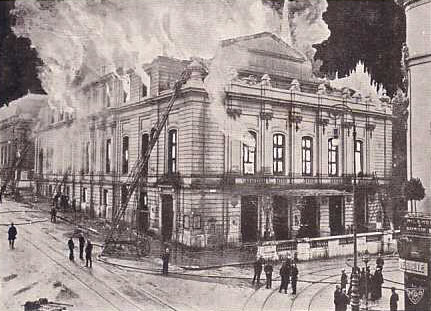|
Sonia Theodoridou
Sonia Theodoridou ( el, Σόνια Θεοδωρίδου, links=no; born 1958) is a soprano from Veria, Greece who has performed prestigious operatic roles internationally. Early life and education Theodoridou was born in Veria in Macedonia, and grew up in Charavgi, a village in Agia Paraskevi, Eordaia. She attended the Greek National Conservatory (founded by composer Manolis Kalomiris), graduating with honors. Theodoridou received a Maria Callas scholarship to study at the Cologne Musical Academy and later moved to London to study with Vera Rózsa. Career She has performed with the Frankfurt Opera, Berlin State Opera, Deutsche Oper Berlin, Hamburg State Opera, National Theatre Munich, Stuttgart State Theatre, Theatre Royal de la Monnaie, Théâtre du Châtelet, Teatro Comunale di Firenze, Teatro la Fenice, Theater Basel, Opéra National de Lyon, Opéra National de Montpellier, Hungarian State Opera House, Athens Concert Hall, Thessaloniki Concert Hall, Herodes Atticus The ... [...More Info...] [...Related Items...] OR: [Wikipedia] [Google] [Baidu] |
Theodoridou
Theodoridis () is a Greek surname. It is a patronymic surname which literally means "the son of Theodoros (Theodore)". Notable people with surname ''Theodoridis'': * Anastasis Theodoridis, Greek journalist * Chrysanthos Theodoridis (1933–2005), Pontic Greek singer *Georgios Theodoridis (born 1972), Greek sprinter *Giorgos Theodoridis (born 1980), Greek footballer * Ioannis Theodoridis, Lufthansa Systems FMS Customer Support specialist *Natassa Theodoridou (born 1970), Greek singer *Savvas Theodoridis (1935–2020), Greek footballer * Sergios Theodoridis, Greek scientist * Stefanos Theodoridis (born 1950), Greek footballer * Thallis Theodoridis (other), multiple people * Theodoros Theodoridis, Greek fashion model *Vasileios Theodoridis Vasileios Theodoridis (Greek: Βασίλειος Θεοδωρίδης) was a Greek journalist and anarchist. Theodoridis was born in Pyrgos and studied law in Athens. He was descended from the famous Theodoridis family and was the son of ... [...More Info...] [...Related Items...] OR: [Wikipedia] [Google] [Baidu] |
Staatstheater Stuttgart
The Staatstheater Stuttgart (Stuttgart State Theatre) is a theatre with three locations, Oper Stuttgart (Opera Stuttgart), Stuttgarter Ballett (Stuttgart Ballet), and Schauspiel Stuttgart (Stuttgart Drama Theatre), in Stuttgart, Germany. The state that its name refers to is Baden-Württemberg. Architecture Designed by the noted Munich architect Max Littmann, who won a competition to create new royal theatres, the building was constructed between 1909 and 1912 as the Königliche Hoftheater, royal theatre of the Kingdom of Württemberg with a Grosses Haus (large house) and a Kleines Haus (small house). In 1919, the theatres were renamed to Landestheater, and later Staatstheater. The house for drama theatre, Kleines Haus, was destroyed by bombing during World War II, and today, the site is occupied by a new Kleines Haus, designed by Hans Volkart, which opened in 1962. The Opera House (Grosses Haus), is one of only a few German opera houses to survive the bombing of World War II. ... [...More Info...] [...Related Items...] OR: [Wikipedia] [Google] [Baidu] |
Delphi
Delphi (; ), in legend previously called Pytho (Πυθώ), in ancient times was a sacred precinct that served as the seat of Pythia, the major oracle who was consulted about important decisions throughout the ancient classical world. The oracle had origins in prehistory and it became international in character and also fostered sentiments of Greek nationality, even though the nation of Greece was centuries away from realization. The Ancient Greece, ancient Greeks considered the centre of the world to be in Delphi, marked by the stone monument known as Omphalos of Delphi, the omphalos (navel). The sacred precinct of Ge or Gaia was in the region of Phocis (ancient region), Phocis, but its management had been taken away from the Phocis (ancient region), Phocians, who were trying to extort money from its visitors, and had been placed in the hands of an Amphictyonic League, amphictyony, or committee of persons chosen mainly from Central Greece. According to the Suda, Delphi took its n ... [...More Info...] [...Related Items...] OR: [Wikipedia] [Google] [Baidu] |
Ancient Theatre Of Epidaurus
The Ancient Theatre of Epidaurus is a theatre in the Greek city of Epidaurus, located on the southeast end of the sanctuary dedicated to the ancient Greek God of medicine, Asclepius. It is built on the west side of Cynortion Mountain, near modern Lygourio, and belongs to the Epidaurus Municipality. Constructed in late 4th century BC, it is considered to be the most perfect ancient Greek theatre with regard to acoustics and aesthetics. Because of its exceptional architecture and aesthetics, the theatre was inscribed on the UNESCO World Heritage List in 1988 along with the Temple of Asclepius. History According to Pausanias, the ancient theatre was constructed at the end of the 4th century BC by the architect Polykleitos the Younger. Pausanias praises the theatre for its symmetry and beauty. At a maximum capacity of 13,000 to 14,000 spectators, the theatre hosted music, singing and dramatic games that were included in the worship of Asclepius. It was also used as a means to heal ... [...More Info...] [...Related Items...] OR: [Wikipedia] [Google] [Baidu] |
Odeon Of Herodes Atticus
The Odeon of Herodes Atticus (Greek: Ωδείο Ηρώδου του Αττικού; also called Herodeion or Herodion; Greek: Ηρώδειο) is a stone Roman theatre structure located on the southwest slope of the Acropolis of Athens, Greece. The building was completed in AD 161 and then renovated in 1950. Ancient times It was built in AD 161 by Herodes Atticus in memory of his Roman wife, Aspasia Annia Regilla. It was originally a steep-sloped theatre with a three-story stone front wall and a wooden roof made of expensive cedar of Lebanon timber. It was used as a venue for music concerts with a capacity of 5,000. It lasted intact until it was destroyed and left in ruins by the Heruli in AD 267. Modern events The audience stands and the orchestra (stage) were restored using Pentelic marble in the 1950s. Since then it has been the main venue of the Athens Festival, which runs from May through October each year, featuring a variety of acclaimed Greek as well as International ... [...More Info...] [...Related Items...] OR: [Wikipedia] [Google] [Baidu] |
Thessaloniki Concert Hall
Thessaloniki Concert Hall ( el, Μέγαρο Μουσικής Θεσσαλονίκης) is a centre for the performing arts in Thessaloniki, Greece. It opened in 2000 on land donated by the Greek state. The complex has two main buildings: M1, with an auditorium that seats 1400; and M2, in more contemporary style by Japanese architect Arata Isozaki, with a number of smaller performance spaces. Artistic director of the Thessaloniki Concert Hall, whose three-year term begins on January 1, 2021, is Christos Galileas, associate professor of violin at Georgia State University. See also * Municipal Theatre of Corfu * Athens Concert Hall * List of concert halls A concert hall is a cultural building with a stage that serves as a performance venue and an auditorium filled with seats. This list does not include other venues such as sports stadia, dramatic theatres or convention centres that ma ... References External links Homepage Modernist architecture in Gree ... [...More Info...] [...Related Items...] OR: [Wikipedia] [Google] [Baidu] |
Athens Concert Hall
The Athens Concert Hall (Greek: Μέγαρον Μουσικής Αθηνών, ''Mégaron Mousikis Athinon'') is a concert hall located on Vasilissis Sofias Avenue in Athens, Greece. The Hall was inaugurated in 1991 with two halls. Since then it has been augmented with two more halls and now has a total of four: two large and two smaller ones. The Hall has optimal facilities for opera performances, and some operas are presented every season. The Megaro Moussikis station of the Athens Metro is just outside the Hall, on Line 3. The design of the 8,000 square meters floor was performed by Christopher Alexander; the process of designing and laying the floor and its result are described in his work '' The Nature of Order: An Essay on the Art of Building and the Nature of the Universe''.Christopher Alexander, ''The Nature of Order: An Essay on the Art of Building and the Nature of the Universe'', , see photo and description on page 264. Performance venues and other facilities *The Ch ... [...More Info...] [...Related Items...] OR: [Wikipedia] [Google] [Baidu] |
Hungarian State Opera House
The Hungarian State Opera House ( hu, Magyar Állami Operaház) is a neo-Renaissance opera house located in central Budapest, on Andrássy út. Originally known as the Hungarian Royal Opera House, it was designed by Miklós Ybl, a major figure of 19th-century Hungarian architecture. Construction began in 1875, funded by the city of Budapest and by Emperor Franz Joseph I of Austria-Hungary, and the new house opened to the public on the 27 September 1884. Before the closure of the "Népszínház" in Budapest, it was the third largest opera building in the city; today it is the second largest opera house in Budapest and in Hungary. Touring groups had performed operas in the city from the early 19th century, but as Legány notes, "a new epoch began after 1835 when part of the Kasa National Opera and Theatrical Troupe arrived in Buda". Legány, p. 630 They took over the Castle Theatre and, in 1835, were joined by another part of the troupe, after which performances of operas were given ... [...More Info...] [...Related Items...] OR: [Wikipedia] [Google] [Baidu] |
Opéra National De Montpellier
The Opéra national de Montpellier Languedoc-Roussillon is an opera company located in the Place de la Comédie in Montpellier, France. The company was established in 1755 and was granted the status of "National Opera" in 2002 by the French Ministry of Culture The Ministry of Culture (french: Ministère de la Culture) is the ministry of the Government of France in charge of national museums and the . Its goal is to maintain the French identity through the promotion and protection of the arts (visual, .... The company uses two main buildings for its performances. The Opéra Comédie, built in the Italian style and opened in 1888, houses a 1,200-seat main auditorium and the 350-seat Salle Molière concert hall. The interior of the Italian-style opera house, built from 1884-88 by Cassien Bernard, a pupil of Charles Garnier, has been noted by critics. Since 1990, the company has also performed at the 2,000-seat Opéra Berlioz in the Le Corum arts complex. [...More Info...] [...Related Items...] OR: [Wikipedia] [Google] [Baidu] |
Opéra National De Lyon
The Opéra National de Lyon, marketed as Opéra de Lyon during the last decade, is an opera company in Lyon, based and performing mostly at the Opéra Nouvel, an 1831 theater that was modernized and architecturally transformed in 1993. The inaugural performance of François-Adrien Boïeldieu's ''La Dame blanche'' was given on 1 July 1831. The Nineteenth and Twentieth Centuries saw some significant French premieres of major operas including Richard Wagner's ''Die Meistersinger'' in 1896, Giordano's '' Andrea Chénier'' in the following year, and Moussorgsky's ''Boris Godunov'' in 1913. In addition, many world premieres such as Arnold Schoenberg's ''Erwartung'' (1967) have been presented. In the years after the 1969 appointment of Louis Erlo as general director, many innovative productions and premieres of both French operas and Twentieth Century operas have been staged. Two significant French artists who have been associated with the Opéra in recent years are the stage director ... [...More Info...] [...Related Items...] OR: [Wikipedia] [Google] [Baidu] |
Theater Basel
Theater Basel is the municipal theatre of the city of Basel, Switzerland, which is home to the city's opera and ballet companies. The theatre also presents plays and musicals in addition to operas and operettas. Because the theatre does not have its own orchestra, the Basel Symphony Orchestra is usually contracted to perform for opera and ballet productions as needed. For baroque-opera productions, La Cetra, the baroque orchestra of the Schola Cantorum Basiliensis, is engaged. History Theater Basel was founded in 1834 under the name Basler Stadttheater. The first theatre was designed by Swiss architect Melchior Berri. In 1873 work on a new theatre began which was designed by Johann Jakob Stehlin Jr.. This second theatre opened in 1875 and was used until it was destroyed by fire on 7 October 1904. Plans for a third theatre were soon made, but it was five years before the theatre finally opened in 1909. The fourth theatre opened in 1975. In October 2018, the company announ ... [...More Info...] [...Related Items...] OR: [Wikipedia] [Google] [Baidu] |
La Fenice
Teatro La Fenice (, "The Phoenix") is an opera house in Venice, Italy. It is one of "the most famous and renowned landmarks in the history of Italian theatre" and in the history of opera as a whole. Especially in the 19th century, La Fenice became the site of many famous operatic premieres at which the works of several of the four major bel canto era composers – Rossini, Bellini, Donizetti, Verdi – were performed. Its name reflects its role in permitting an opera company to "rise from the ashes" despite losing the use of three theatres to fire, the first in 1774 after the city's leading house was destroyed and rebuilt but not opened until 1792; the second fire came in 1836, but rebuilding was completed within a year. However, the third fire was the result of arson. It destroyed the house in 1996 leaving only the exterior walls, but it was rebuilt and re-opened in November 2004. In order to celebrate this event the tradition of the Venice New Year's Concert started. Hist ... [...More Info...] [...Related Items...] OR: [Wikipedia] [Google] [Baidu] |




.jpg)
.jpg)


_-_Facade.jpg)